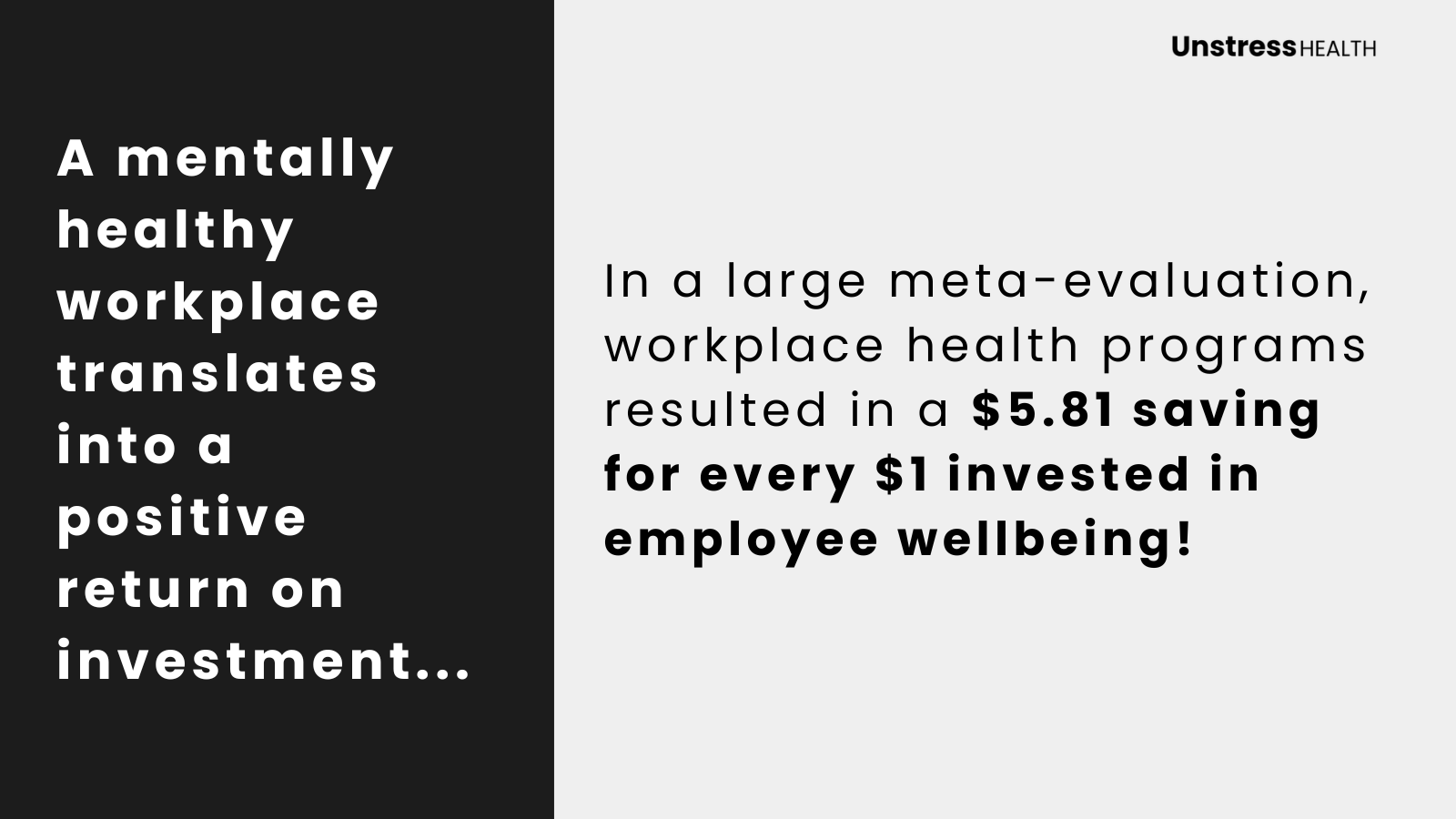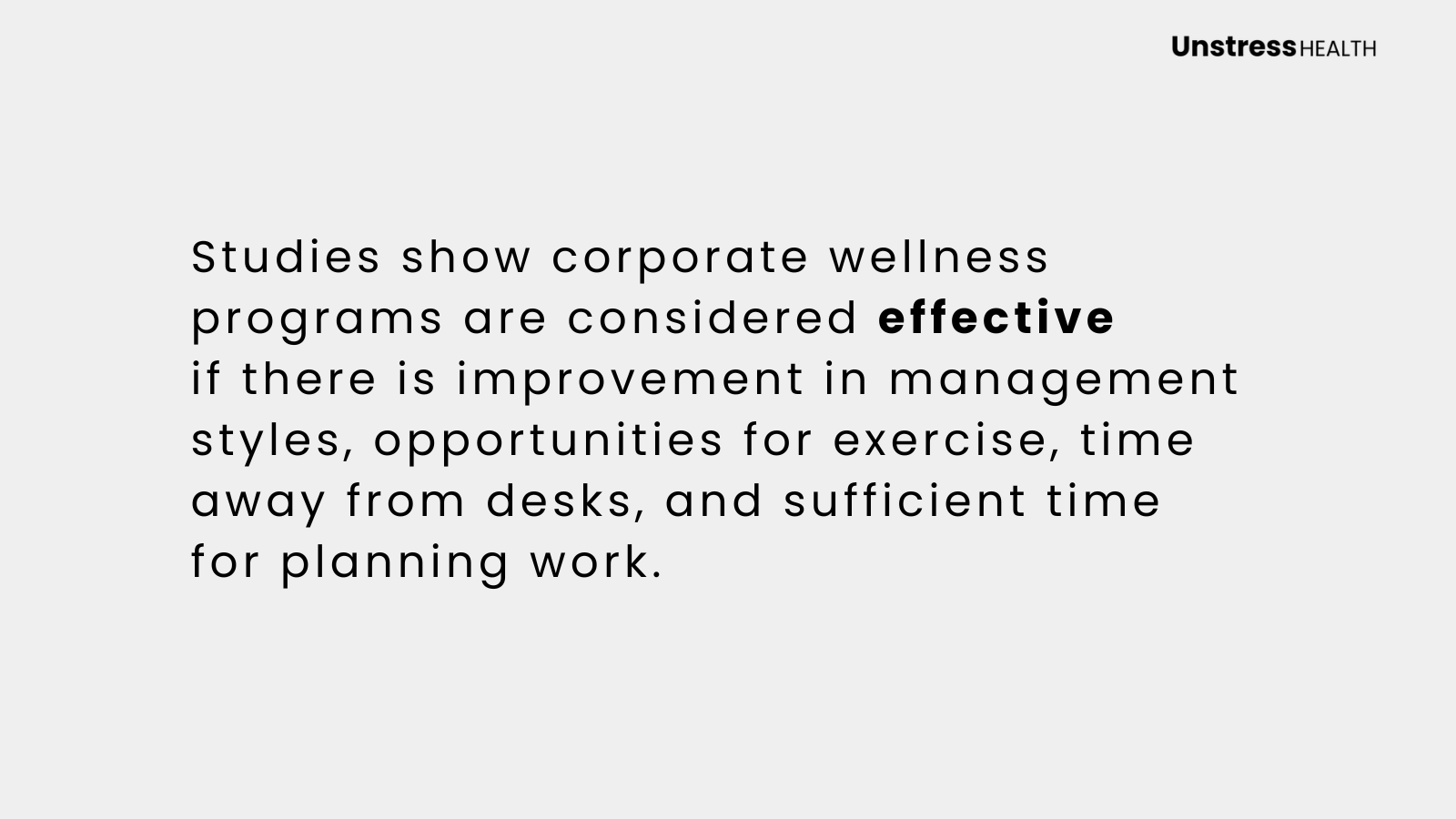The well-being of employees has a direct impact on the productivity of the company.
According to Marvin Weinman, former director of many large, well-known companies in Australia, such as Boral Building and George Weston Foods, health and wellness in the workplace is critical when it comes to the financial health of any company or organisation.
When employees experience stress and a sense of overwhelm, their ability to perform their roles effectively within the company lowers.
In a recent Unstress Health podcast, Unstress Health spoke with Marvin Weinman, who has a track record of driving significant change and improvement programs in large companies, for some further insights.
His experience as a top executive gives him a unique perspective on why the health of your workforce matters, why corporate health programs are a must-have and how this change can be managed to improve organisational health.
The great resignation and the current workplace landscape
Change is inevitable in every sphere of life, and keeping up with change in the corporate world is absolutely essential for any company to stand the test of time.
Against the backdrop of the “great resignation”, it has become increasingly competitive for companies and managers to attract and retain talent. Ongoing changes to where people work, and record-high quit rates are further complicating the role of management within organisations.
Job-hopping can create instability and affect social connections, contributing to an unhealthy workforce.
Staff turnover also has a significant financial cost on a company, in many cases up to 6 or 7 times the annual salary of that position.
The recent trend of “quiet quitting” has also increased. Many jobs have become, or at least feel, 24 hours, 7 days per week, due to a number of factors including expectations (perceived or real), regular performance reviews and technology-enabled flexible working arrangements… which gives employees a sense they are always ‘on’ and available, limiting rest and down time.
Gen Y and Gen Z (& future generations) are realising how this impacts well-being and are less likely to accept the expectation – wanting and seeking out more balance. In addition, Human Resources are having to sell undesirable roles.
Both increasing trends are a symptom of the blurred lines between life and work, and a growing unwell population confused by industry-funded public health messages.
For individuals, self-development and continuing education are crucial, and the best way to ensure personal growth. In the same way employees must keep up with new trends, industry changes and new management tools to enjoy a successful career, companies need to be prepared to implement change to attract and retain talent to set themselves up for success.

How does employee well-being affect productivity?
Reduced work engagement, productivity & performance, combined with higher employee turnover rates and higher levels of compensation claims, can be attributed to an unhealthy workplace. The data adds to the story:
- One in five Australians (21%) have taken time off work in the past 12 months because they felt stressed, anxious, depressed or mentally unhealthy1
- 76% of employees perform below expectation due to mental health problems2
Engagement, Productivity & Performance
Happy, healthy employees are more engaged with the company and are more likely to go out of their way to do a good job3. The result can be seen in your bottom line, with almost every dollar you spend on creating a mentally healthy workplace translating into a positive return on investment4. In a large meta-evaluation, workplace health programs resulted in a $5.81 saving for every $1 invested in employee wellbeing5.

Absenteeism
The financial impact on Australian companies of absenteeism in the workplace is estimated to be $4.7 billion annually. Studies show one out of six people working in Australia suffer from symptoms of depression and anxiety, the leading cause of short- and long-term absenteeism in the workplace6.
Presenteeism & Mental Health
When employees with mental health issues are present at work, productivity is significantly less than when they are mentally healthy. Presenteeism, or showing up for work when unwell, has consequences for employers. It may contribute to employees not getting the assistance and support they require as well as lost productivity for a business.
83% of employees reported going to work despite poor mental health2.
Workplace injury
Workplace injuries cost companies a significant amount of money each year. Not only do companies have to pay high insurance premiums for occupational health and safety, they also have to pay injured employees for lost time at work. If the injuries are serious, this can add up to a substantial amount of money over a long period of time7.
“If you’re having a lot of accidents in your factories, your premiums go up, affecting your bottom line. It’s the same if your factories are down a lot. You will then experience substantial premiums and loss of shareholder value and profits.” ~ Marvin Weinman
While an employee recuperates, the company is left short-staffed as well as losing experience and expertise. In order for organisations to avoid workplace injuries, a focus on preventative maintenance, health, and safety is essential.

The importance of stress management in business
Stress management in the workplace is key to employee health and wellness, and therefore something employers must prioritise.
Sources of stress at work include8:
- Adverse working conditions
- Management practices
- Unrealistic demands
- No support from managers and coworkers
- Unfair treatment
- Poor decision-making skills
- No appreciation for effort and work done
- Feeling overworked and underpaid
- Poor definition of role in the company
- Lack of transparency
- Poor communication
The recent global pandemic hasn’t helped matters. In addition to general concern, employees have found themselves working from home, unable to create a healthy distance between work and home. A report from the ADECCO group states people are now working an average 14% more than they were prior to the pandemic9.
Mental Health and Burnout affecting Managers and Leaders
Mental health has suffered due to the ’always-on’ culture, with 32% of employees reporting a decline in mental health over the last couple of years. It’s not surprising to see the correlation between the increase in poor mental health and the burnout rate.
The ADECCO report states 54% of young business leaders have experienced signs of burnout9.
The younger generation tends to feel the most pressure, which can be detrimental to any growing and expanding business, as they are the future managers and leaders.
Unfortunately, managers are not well trained in identifying signs of overwhelm or burnout. 53% of managers admit being unable to recognise the telltale signs of someone battling mental health, let alone having the tool to support employees.
Similar to healthcare, corporate health operates with a treatment philosophy rather than a preventative philosophy. In other words, it is common practice in the Australian workplace to treat the symptoms of the problem instead of addressing the cause of the problem.
Employee Assistance Programs (AEP)
For example, many organisations have an Employee Assistance Program or EAP (which is a positive thing!). However, these are reactive, rather than proactive initiatives. Furthermore, they have a low utilisation rate, with only 11% of employees choosing to contact their EAP for support2 (i.e. 9 in 10 don’t use this service). In addition:
“Of the 11% who contacted their company EAP, 57% found the program helpful while 42% stated it was not very helpful2“
Doubts around EAPs usefulness and a lack of knowledge around its existence stand out as the main reasons for its underutilisation among those who did not use it. This implies businesses, in collaboration with third-party providers of mental health resources, should continue to raise awareness about their programs, better manage employees’ expectations of their benefits, and ensure programs are designed and delivered to meet employee needs.
The benefits of preventive corporate healthcare
Until recently, corporations had little concern with their employee’s health and safety. However, financial drivers to enhance companies’ prevention strategies have ensured and backed change.
The pandemic is an excellent example of how companies have increased their support in looking after the health and well-being of their employees. At the height of the pandemic, people were instructed to work from home and to wear masks if they went into the office.
Now restrictions have been lifted, many people still work from home. Organisations and their employees have come to realise preventive health strategies are essential for promoting health and preventing disease.
However, health and wellness involves more than working from home and wearing face masks. A great place to start is the implementation of a workplace health program aimed at supporting the health and well-being of employees. Workplace health promotion strategies are essential to address both the causes of physical and mental illness, as well as the early treatment of any kind of poor health10.
Workplace health promotion programs can be targeted at the individual, teaching them useful behavioural strategies to manage stress, or at an enterprise level where policies and environments are created to encourage healthy behaviours at work.
Studies show corporate wellness programs are considered effective if there is an improvement in management styles, opportunities for exercise, time away from your desk, and sufficient time for planning your work8.

The first step in creating a preventative philosophy in the workplace is identifying the focus areas impacting employee health:12
- Career well-being: Do your employees enjoy going to work?
- Social well-being: Do your employees have good social support at work?
- Financial well-being: Do your employees believe their pay is fair?
- Physical well-being: Do your employees enjoy good physical and mental health?
- Community well-being: Do your employees feel connected to the community?
Resisting change: a potential roadblock to improved productivity
“Change is probably the most significant factor in driving stress.” ~ Marvin Weinman
For a business to maintain its relevance in the market, it has to evolve. However, employees are often resistant to change and provide reasoning as to why the proposed changes won’t work. There may be more resignations and requests for transfers and a reduction in productivity13.
Changes can be big or small, ranging from moving desks to more fundamental changes in management tools. The purpose of change is to increase productivity, so understanding your employees’ reasons for opposing the changes is essential in moving the company forward.
How to drive change and minimise employee stress
Just as there is preventive health, there are ways to manage change to prevent or minimise stress. Marvin learnt how to effectively manage change not through textbooks but through managing eight and a half thousand people in a change program.
When an organisation is doing well, they don’t want to undertake a significant change program. Instead, they want to foster stability and enhance the status quo. So, only minor changes may be required.
However, you must implement change when a company isn’t doing well. It’s essential to keep improving, but you may lose your competitive advantage if your competitors change faster and more significantly. So even though you’re improving, you’re going out of business, and that’s when corporates and shareholders demand change.
Change management in a corporate setting is challenging but essential if a company wants to stay in business. If performance and output need to increase, the consequences of maintaining the status quo are severe and will significantly impact employees.
Managers encourage and support their team to be comfortable with change. In order to do this, they have to understand there are certain principles and that doing nothing is not an option.
Change begins from the top down, but getting buy-in on the shop floor can’t be underestimated. For example, the results will be limited when a new CEO talks to his management team and expects them to drive the change they didn’t want.
If the CEO makes a point of visiting the factory floor and talking to the sales reps, explaining who he is and what the vision is for the company, he creates a sense of predictability that minimises some of the stress.
“You want to try and create an environment that is as stress-free as possible.” ~ Marvin Weinman
Connecting with the people on the ground and sharing the reasons why change is needed means creating an understanding of the benefits of participating in change. It’s a more democratic process rather than an audit.
Becoming adaptable to change
Marvin believes the biggest challenge on our health journey in the modern world is becoming adaptable to change because it is unavoidable.
The first stage of your life is childhood and adolescence, driven by a set of factors determining your success. And then you move into the middle years, and you have to reinvent yourself and have more responsibilities.
As an adult, you face numerous changes. For example, you might get married, have children, buy a house, and get your first, second or third job. And then you move into your golden years, which last longer than they ever did.
Change is inevitable, whether in your personal life or career. To stay relevant and succeed at work, you must constantly develop new skills to keep up with the new management tools companies use to boost productivity.
Transform the health of your team and unlock the potential of your business
The need for employers to address and champion mental health and wellbeing in workplaces globally is more pressing than ever.
Employees at all levels of an organisation are affected by stress and mental health issues. Not only do they have an impact on an individual’s life and the lives of their families, but failure to address mental health issues can also impact on workplace productivity, staff turnover, and the long-term success of an organisation.
It’s not just mental health. In today’s world, people are facing an increasing number of health challenges, causing many poor health outcomes.
As the great resignation continues and trends like ‘quite quitting’ pop up, workplace health has progressed from it’s ‘nice to have’, to ‘the right thing to do’ to now becoming a key business performance driver.
Implementation of a corporate health program faces challenges; any change is difficult. However, change is crucial if a company wants to stay in business. If performance and output need to increase, the consequences of maintaining the status quo are severe and will significantly impact employees.
Change begins from the top down, and getting buy-in on the shop floor can’t be underestimated. To set themselves up for success, businesses must be willing to implement change in order to attract and retain talent and ensure they maximise their human capital.
At Unstress Health, understanding stress and how to better manage it in your life is one of our core focuses and the starting point of our corporate health programs. We want to make it easier for companies, managers and their employees to navigate the demands and pressures of the modern world by providing a framework and a language with which to approach stress and the many ways it manifests itself.
Further reading:
Discover the number one factor determining your ability to fulfil your potential and 4 steps to create a healthy workplace.
Been sitting at your desk for too long? Learn 4 easy solutions to prevent forward head posture and associated chronic pain.
References
- Chapman, L.S. (2002) Proof Positive. An Analysis of the Cost Effectiveness of Worksite Wellness. Seattle, WA: Chapman Institute Within: https://www.healthierwork.act.gov.au/wp-content/uploads/2015/01/HAPIA-Best-Practice-Guidelines.pdf
- Mental Health and Wellbeing in the Workplace: Survey of APAC employees. September 2020. Access here: https://www.cmhahk.org/docs/research/CMHA-HK-2020-Mental-Health-&-Wellbeing-in-the-Workplace-Final.pdf
- Why it matters [Internet]. Heads Up. [cited 2022 Oct 13]. Available from: https://www.headsup.org.au/healthy-workplaces/why-it-matters
- Creating a mentally healthy workplace: return on investment analysis [Internet]. Analysis & Policy Observatory | APO. [cited 2022 Oct 13]. Available from: https://apo.org.au/node/39705
- Chapman Larry S. 2007. Proof Positive: An Analysis of the Cost-Effectiveness of Worksite Wellness. 5th ed. Seattle WA: Summex Corp. https://www.worldcat.org/title/proof-positive-an-analysis-of-the-cost-effectiveness-of-worksite-wellness/oclc/54498844
- Developing a mentally healthy workplace: a review of the literature [Internet]. Analysis & Policy Observatory | APO. [cited 2022 Oct 13]. Available from: https://apo.org.au/node/57690
- Data and Research [Internet]. Work Safe Australia. [cited 2022 Oct 13]. Available from: https://www.safeworkaustralia.gov.au/data-and-research/explore-our-data
- Bhui K, Dinos S, Galant-Miecznikowska M, de Jongh B, Stansfeld S. Perceptions of work stress causes and effective interventions in employees working in public, private and non-governmental organisations: a qualitative study. BJPsych Bulletin [Internet]. 2016 Dec [cited 2022 Oct 13];(6):318–25. Available from: http://dx.doi.org/10.1192/pb.bp.115.050823
- Burnout Might Be The New Worker Pandemic. Half Of Leaders Struggle To See The Signs [Internet]. The Adecco Group – the industry leader in Human Resources solutions. [cited 2022 Oct 13]. Available from: https://www.adeccogroup.com/future-of-work/latest-insights/burnout-might-be-the-new-worker-pandemic-half-of-leaders-struggle-to-see-the-signs/
- How to Deal With Resistance to Change [Internet]. Harvard Business Review. https://www.facebook.com/HBR; 1969 [cited 2022 Oct 13]. Available from: https://hbr.org/1969/01/how-to-deal-with-resistance-to-change
- Sargent GM, Banwell C, Strazdins L, Dixon J. Time and participation in workplace health promotion: Australian qualitative study. Health Promotion International [Internet]. 2016 Dec 23 [cited 2022 Oct 13];daw078. Available from: http://dx.doi.org/10.1093/heapro/daw078
- Witters D. Your Top 14 Wellbeing Resolutions for 2021 [Internet]. Gallup.com. Gallup; 2021 [cited 2022 Oct 13]. Available from: https://news.gallup.com/opinion/gallup/328550/top-wellbeing-resolutions-2021.aspx
- How to Deal With Resistance to Change [Internet]. Harvard Business Review. https://www.facebook.com/HBR; 1969 [cited 2022 Oct 13]. Available from: https://hbr.org/1969/01/how-to-deal-with-resistance-to-change






